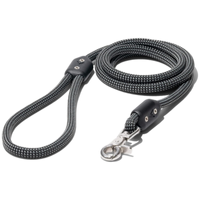This is why some dogs are reactive and how to help them, according to an expert
Work with your dog on alternative behaviors for a happier pup.

Reactive dogs can be tricky to manage, whether your own dog struggles with reactivity or you and your pup have encountered other reactive dogs when you’re out and about. But reactivity isn’t fun for anyone, including the dogs themselves!
If you’d like to know more about why dogs can be reactive and what to do to support them – whether you’re at home with them or they’re outside on one of the best dog leashes – you’re in the right place.
Award-winning trainer Lisa Burton of Listen Dog Training has offered some brilliant insights in a recent Instagram post, and we’ll take a look at them here.
A post shared by Lisa Burton | Listen Dog Training 💁🏻♀️🥇🐕 (@listendogtraining)
A photo posted by on
If you're looking for a high-quality long leash, then this one is a great option. It's made from dry-treated dynamic climbing rope, meaning it's suitable for strong dogs and lasts a "lifetime" (hence the name). Our tester Sarah tried it out on her dog Duke, and describes it as strong, sturdy and game-changing.
“Many reactive dogs aren't choosing to lash out,” Burton explains, “They just don’t know what else to do when they’re overwhelmed by a trigger.”
When a dog is faced with a trigger, they may not know how else to react, maybe because they’ve not experienced or been taught an alternative – leading to reactivity in dogs.
However, it’s more easy than we might think to teach our dogs these alternative behaviors. “With training, we can replace their uncertainty with confidence and control,” continues Burton, who advises practicing the following with your pup:
• Look at me: Teach your dog to make eye contact with you when they encounter a trigger.
PetsRadar Newsletter
Get the best advice, tips and top tech for your beloved Pets
• Sequence patterning: Predictability is good for dogs – if you teach them behavior patterns at home, you can then take them out of the house to practice when there are potential triggers around.
• Leave it: “Growing your dog’s ability to disengage and putting this on cue is a great way to interrupt the loading of their reactive outburst, regain their focus, and redirect it elsewhere,” says Burton.
• U-turn: Teach your dog how they can turn and move away from a trigger calmly and without reacting.
Why not take on board five of the most important dog commands and how to teach them here, too? And remember, when teaching your dog these behaviors it’s important to do so at home, away from triggers, to begin with. “Practice these skills at home, then proof with neutral and then positive distractions so your dog becomes confident in their responses, before they’re faced with their triggers.”
As dog parents, it’s important that we advocate for and support our pups, and part of this is encouraging them to find ways to handle situations that don’t involve lashing out – which we can do with Burton’s advice.
If you’re finding it tricky to be out in public with your reactive dog, you might find this article useful: Owning a reactive dog is hard. Here's how I navigated the social challenges with my pooch.

Adam is a freelance journalist specialising in pets, music and culture, and mental health and wellbeing. He investigates and writes the large majority of news on PetsRadar, and collaborates with veterinary experts to produce informative pet care content.
Adam has a journalism degree from Southampton Solent University and a masters degree in Magazine Journalism from Cardiff University. He was previously senior editor at dog advice website DogTime.com, and has also written for The Independent, GoodToKnow and Healthline.
He owns two rescue cats, Bunny and Dougie, and has also previously had a rabbit, fish and Roborovski dwarf hamsters.

